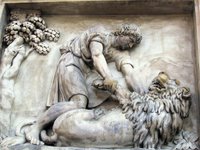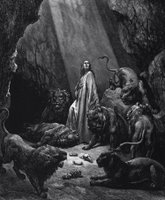Androcles and the Lion
Q: In the Bible, did anyone (such as Daniel) actually remove a thorn from a lion’s paw to befriend it, or is the story of Androcles (a Greek slave) a convolution of the story of Daniel in the lions’ den, which is now commonly assumed to be a parable?
 A: There are no lions with thorny paws in Scripture; our source is Aesop, an ancient compiler and teller of tales. It’s impossible to determine the origin of all of his Fables, but some are considered to originate even before Aesop’s life, which began around 650 BC.
A: There are no lions with thorny paws in Scripture; our source is Aesop, an ancient compiler and teller of tales. It’s impossible to determine the origin of all of his Fables, but some are considered to originate even before Aesop’s life, which began around 650 BC.The Fables are short, effective morality plays and were, incidentally, Martin Luther’s favorite secular works.
As for the story in question, Aesop’s slave was anonymous, but Joseph Jacobs later wrote of “Androcles” and this name stuck. Jacob’s treatment was turned into a witty, if irreverent play by George Bernard Shaw.
 Another version was handed down in “Of the Remembrance of Benefits” from Gesta Romanorum, a collection of Roman tales from England in the 1300s that became part of the stew pot of English-language story telling. Other versions, including light operas, children’s theater productions, and the like have similarly grown from a legend perhaps older than Aesop himself.
Another version was handed down in “Of the Remembrance of Benefits” from Gesta Romanorum, a collection of Roman tales from England in the 1300s that became part of the stew pot of English-language story telling. Other versions, including light operas, children’s theater productions, and the like have similarly grown from a legend perhaps older than Aesop himself.As for the Book of Daniel, I consider the book and its contents to be divinely inspired and truthful. Thus, I assume that the story of the prophet in the lion’s den, the three young men in the furnace, and other narratives are accurate accounts of actual events, not fables nor even divine parables.
Send email to Ask the Pastor.
Walter Snyder is the pastor of Holy Cross Lutheran Church, Emma, Missouri and coauthor of the book What Do Lutherans Believe.

3 Comments:
It's also probably worth mentioning that according to legend, St. Jerome (translator of the Latin Vulgate) befriended a lion by removing a thorn from its paw. In art, Jerome is often depicted with a lion as an attribute.
Thank you Pastor Snyder for stating that the Book of Daniel is historical fact not a parable. As one Johnie to another lets not apply our reasoning to Gods word.
It's worth noting that Aulus Gellius wrote of Androcles in Noctes Atticae. This was written in the 2nd century A.D. and was attributed by Aulus Gellius to Apion, who lived in the 1st century.
Post a Comment
<< Home